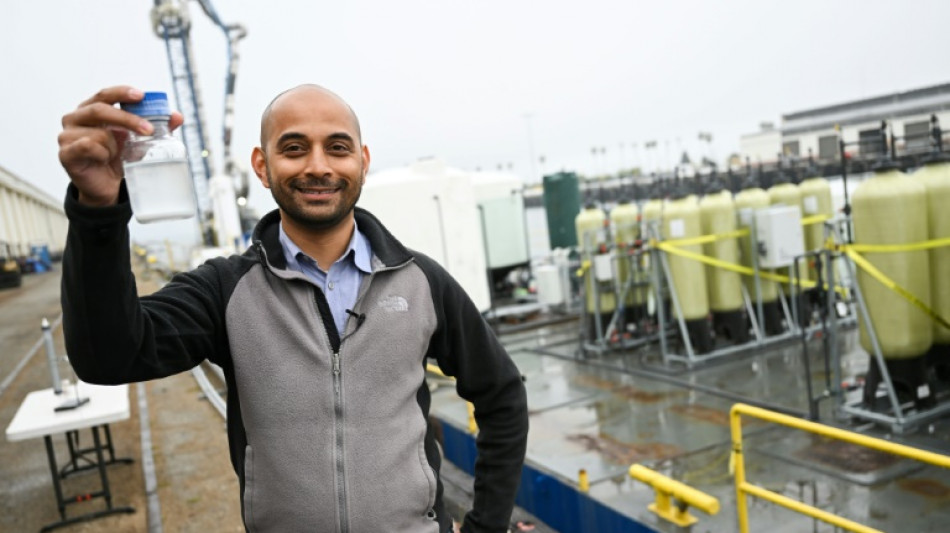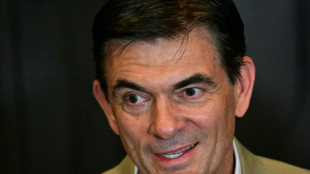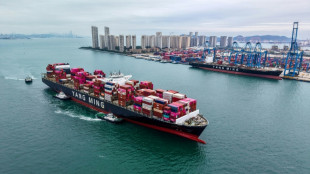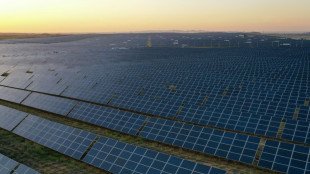
-
 Trump warns Hamas not to breach Gaza deal as Vance heads to Israel
Trump warns Hamas not to breach Gaza deal as Vance heads to Israel
-
China hawk Takaichi named Japan's first woman PM

-
 Sanae Takaichi, Iron Lady 2.0 poised to be Japan PM
Sanae Takaichi, Iron Lady 2.0 poised to be Japan PM
-
Liverpool's Ekitike returns to face floundering Frankfurt

-
 Cape Verde captain getting to grips with 'dream' World Cup qualification
Cape Verde captain getting to grips with 'dream' World Cup qualification
-
'Enhancing the game': Football Manager includes women's clubs

-
 France's ex-president Sarkozy to be jailed over Libya funding conviction
France's ex-president Sarkozy to be jailed over Libya funding conviction
-
Blue Jays sink Mariners to reach World Series

-
 France intensifies hunt for Louvre raiders
France intensifies hunt for Louvre raiders
-
EU takes aim at plastic pellets to prevent their nightmare cleanup

-
 Equities rally on China-US hopes, new Japanese PM lifts Tokyo
Equities rally on China-US hopes, new Japanese PM lifts Tokyo
-
'Dream come true' for US pianist Eric Lu after Chopin competition win

-
 Nepal's 'hidden' mountains draw new wave of climbers
Nepal's 'hidden' mountains draw new wave of climbers
-
Climate change, population growth threats as malaria fight stalls

-
 EU timber imports linked to deforestation on Indonesia's Borneo: NGOs
EU timber imports linked to deforestation on Indonesia's Borneo: NGOs
-
Canada crime bill and rap group fracas spark free-speech debate

-
 Peru's Gen Z lead movement against crime, political paralysis
Peru's Gen Z lead movement against crime, political paralysis
-
Migrants brace for hostile climate after Chile's election

-
 Trump demolishes part of White House for new ballroom
Trump demolishes part of White House for new ballroom
-
Nuno admits Hammers 'have a problem' after Brentford defeat

-
 Maccabi Tel Aviv to decline tickets for European tie at Aston Villa
Maccabi Tel Aviv to decline tickets for European tie at Aston Villa
-
US, Australia sign rare earths deal as Trump promises submarines

-
 Former Bucs running back Martin died in custody: police
Former Bucs running back Martin died in custody: police
-
US confirms Mexico, Costa Rica, Jamaica as co-hosts for 2031 Women's World Cup bid

-
 Mourinho expects more Newcastle silverware after League Cup triumph
Mourinho expects more Newcastle silverware after League Cup triumph
-
Crisis-hit Argentina inks $20 bn rescue with US

-
 US appeals court says Trump can deploy soldiers in Portland
US appeals court says Trump can deploy soldiers in Portland
-
Colombia awaits ruling on ex-president Uribe's house arrest

-
 Disgraced Andrew may face more legal woes: UK biographer
Disgraced Andrew may face more legal woes: UK biographer
-
Disgraced Prince Andrew may face more legal woes: UK biographer

-
 Dembele, Marquinhos return for PSG's trip to Leverkusen
Dembele, Marquinhos return for PSG's trip to Leverkusen
-
Bolivia's president-elect says will resume ties with US after nearly two decades

-
 Shaheen Afridi appointed Pakistan ODI captain for South Africa series
Shaheen Afridi appointed Pakistan ODI captain for South Africa series
-
Howe looking forward to facing 'incredible' Mourinho in Champions League

-
 Athapaththu conjures miracle as Sri Lanka snatch victory over Bangladesh
Athapaththu conjures miracle as Sri Lanka snatch victory over Bangladesh
-
Trump to Australian ambassador: 'I don't like you either'

-
 Servers, software and data: how the cloud powers the web
Servers, software and data: how the cloud powers the web
-
Trump says Australia will get submarines as PM visits

-
 Athletes swap skis for skates in a glimpse of winter sport's future
Athletes swap skis for skates in a glimpse of winter sport's future
-
Brazil greenlights oil drilling in sensitive Amazon region

-
 Struggling Rangers appoint Rohl as new manager
Struggling Rangers appoint Rohl as new manager
-
Louvre heist: five things to know about missing jewellery

-
 Stock markets climb as China-US trade fears ease
Stock markets climb as China-US trade fears ease
-
Colombia recalls ambassador to US as Trump-Petro feud intensifies

-
 Louvre stays closed as France hunts jewel thieves
Louvre stays closed as France hunts jewel thieves
-
UK lawmakers urge govt to strip Prince Andrew of his titles

-
 US begins sending nuke workers home as shutdown drags
US begins sending nuke workers home as shutdown drags
-
Dembele returns for PSG after six weeks out

-
 Pope Leo holds first meeting with abuse survivors' group
Pope Leo holds first meeting with abuse survivors' group
-
'I probably have to change my behaviour', Flick says after red card


'Big sponge': new CO2 tech taps oceans to tackle global warming
Floating in the port of Los Angeles, a strange-looking barge covered with pipes and tanks contains a concept that scientists hope to make waves: a new way to use the ocean as a vast carbon dioxide sponge to tackle global warming.
Scientists from University of California Los Angeles (UCLA) have been working for two years on SeaChange -- an ambitious project that could one day boost the amount of CO2, a major greenhouse gas, that can be absorbed by our seas.
Their goal is "to use the ocean as a big sponge," according to Gaurav Sant, director of the university's Institute for Carbon Management (ICM).
The oceans, covering most of the Earth, are already the planet's main carbon sinks, acting as a critical buffer in the climate crisis.
They absorb a quarter of all CO2 emissions, as well as 90 percent of the warming that has occurred in recent decades due to increasing greenhouse gases.
But they are feeling the strain. The ocean is acidifying, and rising temperatures are reducing its absorption capacity.
The UCLA team wants to increase that capacity by using an electrochemical process to remove vast quantities of CO2 already in seawater -- rather like wringing out a sponge to help recover its absorptive power.
"If you can take out the carbon dioxide that is in the oceans, you're essentially renewing their capacity to take additional carbon dioxide from the atmosphere," Sant told AFP.
- Trapped -
Engineers built a floating mini-factory on a 100-foot (30-meter) long boat which pumps in seawater and subjects it to an electrical charge.
Chemical reactions triggered by electrolysis convert CO2 dissolved in the seawater into a fine white powder containing calcium carbonate -- the compound found in chalk, limestone and oyster or mussel shells.
This powder can be discarded back into the ocean, where it remains in solid form, thereby storing CO2 "very durably... over tens of thousands of years," explained Sant.
Meanwhile, the pumped water returns to the sea, ready to absorb more carbon dioxide from the atmosphere.
Sant and his team are confident the process will not damage the marine environment, although this will require further testing to confirm.
A potential additional benefit of the technology is that it creates hydrogen as a byproduct. As the so-called "green revolution" progresses, the gas could be widely used to power clean cars, trucks and planes in the future.
Of course, the priority in curbing global warming is for humans to drastically reduce current CO2 emissions -- something we are struggling to achieve.
But in parallel, most scientists say carbon dioxide capture and storage techniques can play an important role in keeping the planet livable.
Carbon dioxide removal (CDR) could help to achieve carbon neutrality by 2050 as it offsets emissions from industries which are particularly difficult to decarbonize, such as aviation, and cement and steel production.
It could help to tackle the stocks of CO2 that have been accumulating in the atmosphere for decades.
- 'Promising solution' -
Keeping global warming under control will require the removal of between 450 billion and 1.1 trillion tons of CO2 from the atmosphere by 2100, according to the first global report dedicated to the topic, released in January.
That would require the CDR sector "to grow at a rate of about 30 percent per year over the next 30 years, much like what happened with wind and solar," said one of its authors, Gregory Nemet.
UCLA's SeaChange technology "fits into a category of a promising solution that could be large enough to be climate-relevant," said Nemet, a professor at the University of Wisconsin-Madison.
By sequestering CO2 in mineral form within the ocean, it differs markedly from existing "direct air capture" (DAC) methods, which involve pumping and storing gas underground through a highly complex and expensive process.
A start-up company, Equatic, plans to scale up the UCLA technology and prove its commercial viability, by selling carbon credits to manufacturers wanting to offset their emissions.
In addition to the Los Angeles barge, a similar boat is currently being tested in Singapore.
Sant hopes data from both sites will quickly lead to the construction of far larger plants that are capable of removing "thousands of tons of carbon" each year.
"We expect to start operating these new plants in 18 to 24 months," he said.
O.M.Souza--AMWN



